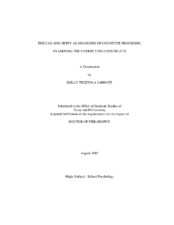| dc.description.abstract | Although there appears to be increasing popularity in neuropsychology across
disciplines of study, only modest work has been conducted with preschool and schoolage
children. Changes in the structure of cognitive processes during early childhood and
the extent of frontal lobe maturation are important to consider when conducting
assessments with young children. Many neuropsychological theories, however, are based
primarily on adult research (e.g., Luria’s theory) and respective assessment measures are
often the extension or slight modification of items from adult assessments. Because
adults and children differ on a number of neuropsychological measures, especially at
younger ages, the same underlying constructs and interpretive strategies may not be
appropriate for use with young children. The CAS and NEPSY are two assessment
measures based on Luria’s theory; however, each posits a different conclusion regarding
the number of factors that explain neuropsychological functioning in young children.
Luria asserted that neuropsychological functioning is comprised of three functional
units, while Naglieri and Das (e.g., CAS) suggested a four factor model, and the authors
of the NEPSY declared a five factor model of functioning. Due to the emerging development of a child’s frontal lobes, and the inconsistency regarding the number of
factors related to neuropsychological functioning in young children, this study examined
the CAS and NEPSY using factor analyses and model fit indices to determine the
underlying structural model(s). The study also examined the usefulness of combining
specific subscales from the CAS, NEPSY, and Peabody Picture Vocabulary Test-III
(PPVT-III; Dunn & Dunn, 1997) to create a cross-battery approach to assessing
neuropsychological functioning in young children. In addition to the CAS, NEPSY, and
PPVT-III, data was obtained from the Behavioral Assessment System for Children
(BASC; Reynolds & Kamphaus, 1992), and the Behavior Rating Inventory of Executive
Function (BRIEF; Gioia, Isquith, Guy, & Kenworthy, 2000) to gather background
information and to assess parent and teacher ratings of behavioral and
neuropsychological functioning. | en |


